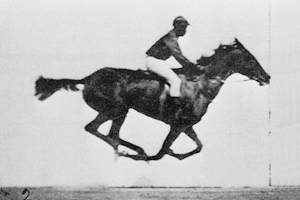Task THREE
The Moving Image world
Pioneers of the moving image
The digital age and the moving image has forever changed the visual landscape of graphic design. It has enabled the designers to try more ideas quickly, and produce more complex and personalised solutions. Most notably, it has empowered designers to create their own images rather than illustrators. Type itself can be the illustrative element.
(April 9 1830 - May 8 1904) is a British photographer that invented the zoopraxiscope, this was first shown in 1879, which was a primitive version of later motion picture devices which worked by showing a sequence of still photographs in rapid succession. Muybridge, perhaps best known today for his sequence of photographs of a race horse in motion (which proved for the first time that at top speed all feet leave the ground), studied photography in the early 1860s with daguerrotypist Silas Selleck and later achieved recognition for his photographs of the Yosemite Valley and other scenes of the American Far West. The zoopraxiscope emerged out of his studies of motion as shown in sequences of still photographs. His 11-volume work, Animal Locomotion , published in 1887, contained over 100,000 photographs. In 1893, he lectured at Zoopraxigraphical Hall at the World's Columbian Exposition in Chicago..
The Zoopraxiscope



 Saul Bass (May 1920 to April 25 1996) was an American graphic designer and acasemy award winning filmaker, but is best known for his design on animated motion picture title sequence. During his peak time of his career he has collabrated with Alfred Hitchcock, Otto Preminger and Martin Scrosese. In the 80's and 90's it seems as though every movie and TV programme had the title sequence of the saul Bass's influences like Tom and jerry has its lion roaring at the start and then appears to have a mysterious music title sequence, James bond with its silhouette of Bond and the stylish women and even Pink panther with its well known recognise instrumental playing in the background. I wouldn’t be surprise if Saul Bass himself designed it, as he was the prime time king of the contemporise animated digital media.
Saul Bass (May 1920 to April 25 1996) was an American graphic designer and acasemy award winning filmaker, but is best known for his design on animated motion picture title sequence. During his peak time of his career he has collabrated with Alfred Hitchcock, Otto Preminger and Martin Scrosese. In the 80's and 90's it seems as though every movie and TV programme had the title sequence of the saul Bass's influences like Tom and jerry has its lion roaring at the start and then appears to have a mysterious music title sequence, James bond with its silhouette of Bond and the stylish women and even Pink panther with its well known recognise instrumental playing in the background. I wouldn’t be surprise if Saul Bass himself designed it, as he was the prime time king of the contemporise animated digital media.The title sequence he has worked on are:
Carmen Jones (1954)
The Man with the Golden Arm (1955)
The Seven Year Itch (1955)
Around the World in Eighty Days (1956)
Bonjour Tristesse (1958)
Vertigo (1958)
Anatomy of a Murder (1958)
The Big Country (1958)
North by Northwest (1959)
Psycho (1960)
Spartacus (1960)
Exodus (1960)
Advise and Consent (1960)
Ocean's Eleven (1960)
West Side Story (1961)
Walk on the Wild Side (1962)
The Victors (1963)
Nine Hours to Rama (1963)
It's a Mad, Mad, Mad, Mad World (1963)
The Cardinal (1963)
In Harm's Way (1965)
Bunny Lake Is Missing (1965)
Grand Prix (1966)
Seconds (1966)
Broadcast News (1987)
Big (1988)
The War of the Roses (1989)
Goodfellas (1990)
Cape Fear (1991)
Doc Hollywood (1991)
Age of Innocence (1993)
Casino (1995)
Ocean's Eleven title sequence
Saul Bass poster design of the film Vertigo

 Jan Švankmajer (born 4 September 1934 in Prague) is a Czech surrealist artist. His work spans several media. He is known for his surreal animations and features, which have greatly influenced other artists such as Tim Burton, Terry Gilliam, The Brothers Quay and many others.
Jan Švankmajer (born 4 September 1934 in Prague) is a Czech surrealist artist. His work spans several media. He is known for his surreal animations and features, which have greatly influenced other artists such as Tim Burton, Terry Gilliam, The Brothers Quay and many others.Contents. Jan Svankmajer is an inspiration to me, pioneering through the digital world since his known for his intriguing animation I have followed this person for a while now and in my opinion the strongest point he specialises must be the clay/surreal animation. Often he experiments several medias in his animation and the creativity inside his mind are extremes, he should really be classed as a surrealist filmmaker as his work moves effortlessly between animation and live action. The pace and rhythm of the editing is superb and his work is a must for those who are into something a little bit darker or
political.
This piece is a great introduction to his work, Dimensions of Dialogue. On top is part 1, and below part 2.
“The world is divided into 2 unequal camps - those who have never heard of Jan Svankmajer and those who happen upon his work and know that they have come face to face with genius” The New Yorker
posted by Simon Genesis @ 05:31,
![]()
0 Comments:
The Authors
About This Blog
This blog discusses the current visual, social and technological debates in design. Albert Einstein said, “The secret to creativity is knowing how to hide your sources,” but what the hell did he know anyway?


Post a Comment